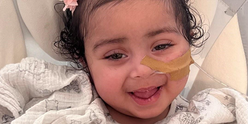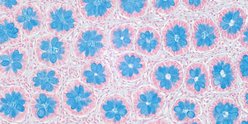Genetic test could help predict risk of eye inflammation in children with juvenile idiopathic arthritis
27 Nov 2024, 10:07 a.m.
Combining genetic and clinical information could help to predict which children with juvenile idiopathic arthritis (JIA) are more likely to develop a serious eye condition that can cause blindness, new research from the CLUSTER consortium has shown.
The CLUSTER Consortium is a UK-wide group of researchers led by Prof Lucy Wedderburn of UCL Great Ormond Street Institute of Child Health (UCL GOS ICH) and Prof Kimme Hyrich at the University of Manchester. The CLUSTER consortium is funded by the Medical Research Council, Great Ormond Street Hospital Charity (GOSH Charity), Versus Arthritis, the NIHR, Fight for Sight, and Olivia’s Vision.
It consists of a multidisciplinary team of clinicians, researchers and industry partners, together with a network of patients and parents (CLUSTER Champions), dedicated to improving the care of children and young people with arthritis and associated uveitis.
Uveitis associated with JIA
JIA is the most common childhood inflammatory rheumatological condition and affects 1 in 1,000 children under 16 years old in the UK. Uveitis, which involves inflammation of the eye, is the most common co-occurring condition of children with JIA – affecting up to 30% of patients.
Uveitis associated with JIA can often begin with no symptoms, and if left undetected or untreated, severe complications can occur – leading to loss of vision. This makes it extremely important to detect the risk of uveitis as early as possible to stop the onset of the disease and maintain quality of life for children and young people with JIA.
A CLUSTER Champion with lived experience of uveitis explains: “Living with uveitis has been a rollercoaster – most of the time I forget it’s there. It’s well controlled now, but when it wasn’t it was frightening as you can’t see the signs but just have to keep going for screening and checks.”
How uveitis is currently diagnosed
Several screening guidelines for uveitis associated with JIA currently exist, based solely on clinical assessment. Clinicians typically look at factors such as how old a child is, their gender, onset of disease and disease subtype.
However, experts reviewing this guidance consider it to be suboptimal in recommending who should be screened, when screening should occur, and what cut-off thresholds should be used for the various risk factors identified. This can often result in frequent hospital visits for a child and their family and highlights the need to improve screening for uveitis.
Lucy Wedderburn, Professor in Paediatric Rheumatology at UCL and Consultant at GOSH, and Principal Investigator for the CLUSTER Consortium says: “Currently, uveitis is screened for in the clinic – in all children with JIA. However, this means that many children who will never get uveitis still have to undergo repeated screening.”
What role do genetics play in JIA and uveitis?
JIA and uveitis are autoimmune diseases, both with genetic and environmental risk factors.
A specific area of our genome (our complete set of genetic instructions) – called the human leukocyte antigen (HLA) region – is well known to contribute to autoimmune diseases, as many genes within this region have a role to play in our immune system.
Previous research has shown that variations in the HLA region contribute to the development of uveitis. The CLUSTER research team was interested to learn more about this link, and how it might be used to improve the diagnosis of children with uveitis.
What the new research tells us
Researchers from the CLUSTER consortium compared specific genes within the HLA region in children and young people with JIA with and without uveitis.
The findings showed differences in the frequency of certain genetic variants in children with uveitis compared with those without uveitis. Importantly, these genetic differences identified the children at greater risk of uveitis, independently of the clinical assessment score. This means that both genetic and clinical information are helpful in predicting the risk of uveitis, and by combining the scores, clinicians can more accurately predict which children are most likely to develop the condition.
Dr Melissa Tordoff, CLUSTER researcher explains: “The genetic score being independent is very important as this tells us that genetics adds risk information not captured by the clinical score to improve the ability to predict uveitis.”
Translating findings to the clinic
This research provides initial evidence that using genetic risk factors could help to classify which patients might be at most risk of developing uveitis.
The researchers will now work to validate their findings, before hopefully translating the information into the clinic to improve the screening process for uveitis in patients with JIA.
If they’re successful, adding the genetic risk score to the screening process could help doctors recognise and prioritise children and young people at high risk for uveitis, which could help to prevent patients developing a severe disease that leads to permanent visual impairment.
''Those who are high risk for uveitis may have increased frequency of screening for an increased length of time so that ophthalmologists can monitor the patient for uveitis. Those who are defined as low risk may have less frequent screenings over a decreased length of time, which will benefit the patient and family in terms of stress and hospital visits.''
Meet Trinity
Trinity loves horse riding, cricket club, PE and dance – and wants to be a penguinologist!
She has a very full life, and despite some fatigue from her JIA, her condition has not stopped her ambitions for the future.
Trinity was just two years old when she started to experience pains in her foot. Initially misdiagnosed as a fracture, her symptoms became worse over time, leaving her unable to walk. Trinity was referred to GOSH, where she was finally diagnosed with polyarticular juvenile idiopathic arthritis (JIA) just before her third birthday.
Trinity was also affected by uveitis shortly after she was diagnosed with JIA. Thankfully, her condition was identified early enough that it could be treated and brought under control. However, this was almost not the case.

Trinity’s mum, Rebecca, explains:
“Our GOSH consultant advised us to make sure we were seen by our local ophthalmologist urgently. I had to continuously chase for an appointment. Once we were finally seen, I remember the local eye specialist looking at me and saying, ‘Thank goodness you brought her in today – she has uveitis in both eyes.’
“I just think, imagine if we hadn’t had that advice from Great Ormond Street. Imagine if I hadn’t chased it up. Imagine if we had just kept waiting.”
Rebecca was also diagnosed with JIA when she was younger, and Trinity’s dad, Richard, is a CLUSTER Champion.
Rebecca says the CLUSTER research is “a positive and welcome step in the right direction.”
“It brings us closer to answering one of the many questions about JIA that have remained for too long. A predictive test for uveitis could enable earlier detection of the condition and closer monitoring. It also gives us insight into what the future holds for our child – and that insight is very important.
“The potential to reduce the burden of hospital visits for those at low risk of uveitis is also huge – appointments often require us to take a whole day out of school/off work and the cost of transport to appointments can really add up too."
For more information, read the full publication.






